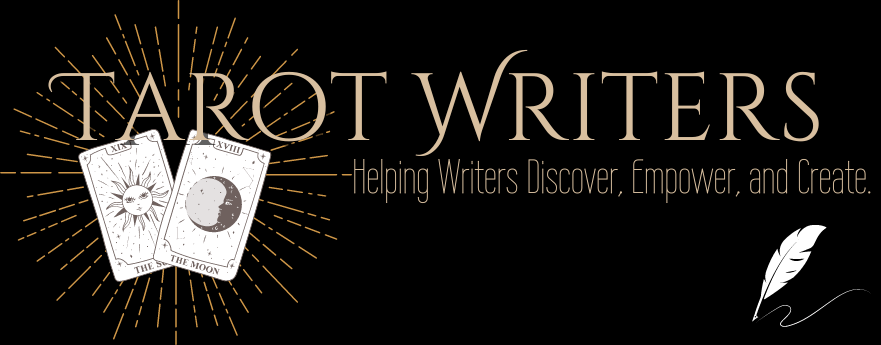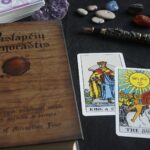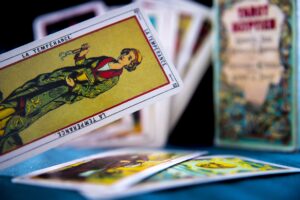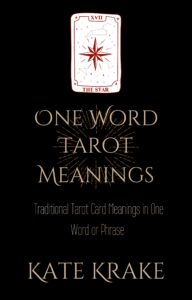How To Start Reading Tarot – A Quick Guide For Writers
Performing a tarot spread is not a complicated process. But the act of interpreting the cards and their positions in the spreads is complex and needs some unpacking for beginners. This article starts that unpacking.
This is not an exhaustive How To about everything there is to know about tarot (No single tarot resource could provide that!), but it will get you started with reading your cards and bringing the expanse of creative possibilities of tarot into your writing world.
Learn The Language
Familiarize yourself with the basic terms used in tarot culture. This tarot glossary is a good place to start.
Get A Deck
Choose whichever deck you like the look of. I typically advise new practitioners to choose a deck with some thematic relevance to their writing. This will usually mean the deck resonates with your personality as well. This article about choosing a deck goes into more details on how that process has worked for the decks I use for my writing.
This article explores some decks with specific literary themes, but any deck with art you enjoy will work for you whether it’s specifically created with writers in mind or not.
Read the Little White Book
Many, if not most, tarot decks come with their own guidebook, aka the Little White Book (LWB). At the very least, this guide is usually a small white pamphlet (hence LWB) with a brief description of each card’s meaning.
These little guides are typically superficial, so you won’t find your whole tarot life in its pages, but it’s the best place to start learning meanings because it is specific to that deck you’re holding.
I use the LWB as shorthand for any guidebook that accompanies a specific deck, whether it’s little or white at all. I own numerous decks with huge tomes to guide through the deck. In addition to card meanings, some of these also contain poetry, stories, and details about how the cards were created.
Look Through The Cards
As you’re reading the LWB, explore the cards themselves, getting to know the art and getting curious about the symbology.
Start Playing With Spreads
There’s no right or wrong way to perform a tarot spread, so cast off any fears you’re “doing it wrong” and just start spreading cards. Follow a formally guided spread if you want (like the traditional Celtic Cross spread, for example), or just lay out some cards however you like while you’re thinking of a specific premise or problem and see what happens.
If you are keen to follow formal guided spreads, my book Tarot Spreads for Writers has plenty to choose from, as well as guidance on how to create your own formal spreads.
You may like to record your spreads and your interpretations in your journal.
Apply Tarot To Your Writing
You might also be learning tarot to apply to your non-writing, wider life (as I do too), but you’re here as a writer looking to expand your creativity.
Again, there’s no right or wrong way to do this. Look into the cards and see what they make you think of. You can use them to prompt story ideas, or expand and deepen your existing ideas. Use them to guide characters into new directions. Writers have used tarot to outline entire stories (the tarot itself contains a narrative, so it’s quite handy for that). You might find characters in the archetypes, or character traits (is your protagonist a classic Queen of Cups, for example?)
Expand Your Knowledge of The Traditional Meanings
As you’re getting familiar with the cards, and the whole tarot world feels more comfortable and less like some esoteric occult society from which outsiders are forbidden, start to expand your understanding of the cards’ traditional meanings.
Read lots of tarot books and websites and see how these writers have interpreted the card meanings. Biddy Tarot is my favorite online resource for card meanings, as the author, Brigit Esselmont, always finds a rounded yet ultimately optimistic interpretation of each card, even the super dark cards.
Some tarot practitioners will learn the traditional meanings by rote and stop consulting the guidebooks when they’re done. I’m not one of these readers, and you don’t have to be either.
Keep consulting the books and other guides as often as you like. The card meanings will stick in your head eventually, or they won’t. It doesn’t matter. Your tarot, your way.
7. Start Leaning into Intuitive Readings
You’re getting to know what other people have said the cards mean, so now it’s time to think about what the cards mean to you. This is called intuitive reading, and I’ve written more about it in this article – Intuitive Tarot – How To Read Cards Without The Books.
I like to combine traditional meanings with my intuitive interpretations.
8. Keep Playing, Keep Learning
Even the most renowned tarot expert will never learn everything there is to know about tarot. Just like we will never learn all there is to know about writing and reach some final summit. There are always more trails on the journey. Keep following them.


 Previous Post
Previous Post Next Post
Next Post






